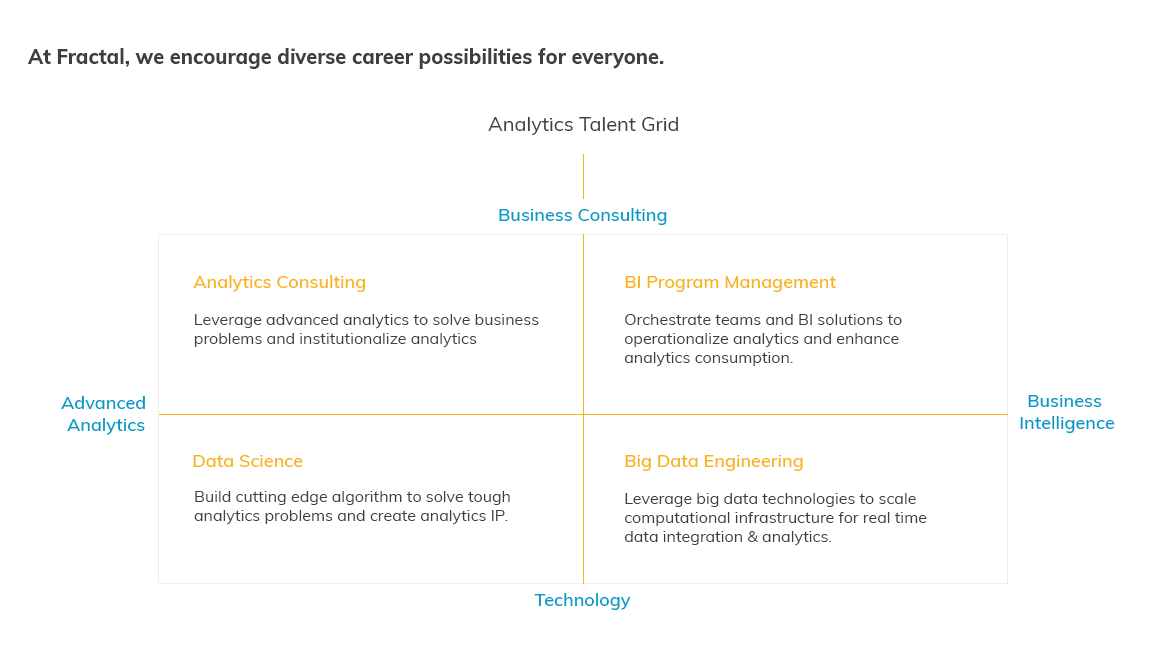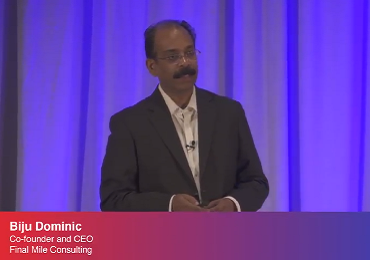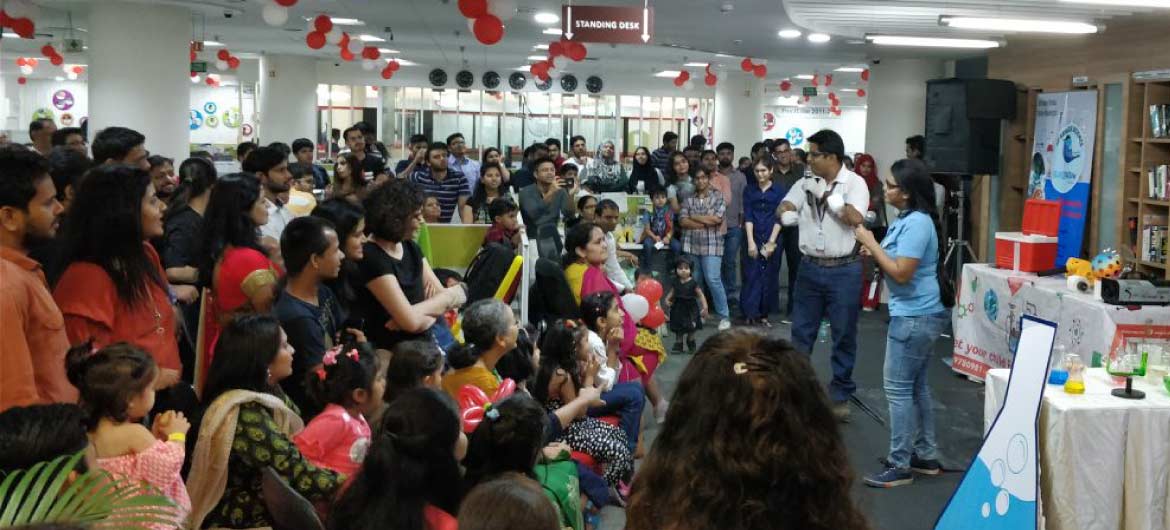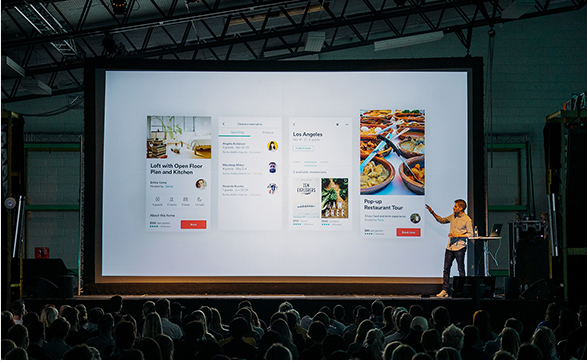AI-based analytics on satellite images can be used to detect traffic in real-time, analyze parking lots, and segment buildings. AI can also be used for business use cases in maritime piracy detection, deforestation detection, and fire and smoke identification.
Insurers can improve their auto claims estimates by using automated AI image identification to analyze external damage to cars, identify affected parts, and detect car brands.
Using image analytics, CPGs can see ‘shelf share’ metrics for brands and be notified if any are out of stock. Analytics can even determine if retailers are complying with CPG’s ideal product placement on the shelf.
Detecting and recognizing objects in images and videos can reveal insights that drive value. Face-recognition systems on real-time video feeds can assist with security surveillance or managing attendance. AI can also identify brands and logos to detect specific products in shopping aisles.
Improve your end-to-end delivery efficiency: from managing orders to last-mile deliveries. Enhance your ability to manage finished inventories, assets, transportation, distribution resource planning, carrier selection, and end-to-end warehouse processes, all while effectively identifying key drivers of service levels.
Enhance your delivery processes with:
- Warehouse BI: Generate visibility and optimize pick, pack, and ship accuracy across warehouse processes.
- Logistics and route optimization: Identify the best shipment method, truck type, and vehicle fill rate optimization across your transportation nodes.
- Order fulfilment: Allocate customer orders to DCs, and improve visibility for better end-to-end order management processes.
- Service levels: Identify key drivers of service levels, and optimize drivers to improve service-level performance.
Improve your manufacturing efficiency and production planning with connected insights across QCDMS components of production. Achieve real-time visibility across manufacturing processes with components of reliability engineering like predictive maintenance and time to failure parameters.
Optimize your manufacturing processes with:
- IIOT analytics: Predict production anomalies in real-time, and enable plant users to identify key drivers leading to unplanned system downtime.
- Shop floor analytics: Predict ‘time to failure’ for assembly lines, analyze drivers of system downtime, and increase production line availability.
- Capacity and demand modelling: Estimate the right manufacturing capacity that an organization has to invest in to meet 100% service levels.
- Quality control: Predict off spec production through production line drivers and prescribe counter measures to produce end product.
You’ll effectively source the right product, from a right place, at the right time. You’ll drive efficient processes to reduce total cost of ownership, streamline spends across the portfolio, enhance vendor performance evaluation and consolidation, improve sourcing replenishment and frequency, and manage payment terms to release working capital savings.
Reimagine your sourcing capabilities with better
- Commodity modelling: Achieve the right sourcing frequency and volume by forecasting future commodity prices.
- Strategic supplier management: Reduce spend disaggregation and bring down the total cost of ownership for sourcing a product.
- Supplier performance analytics: Evaluate vendor performance and vendor consolidations opportunities.
- Spend analytics: Generate visibility across spend at varied organizational functions. Enable your procurement teams to optimize procurement costs by benchmarking vendors and providing a glide path for savings by changing payment terms.
In the planning phase, you’ll use data insights to balance resources with requirements and establish relations for executing processes for source, make, and deliver processes. You’ll align your supply chain plan with financial plans by managing key business rules, evaluate supply chain performance, optimize your network, re-design your supply network, and better plan inventories.
Transform your planning capabilities with improved:
- Demand planning: Align demand using the right forecasts to ensure high levels of accuracy.
- Network design: Use various tools and analytical techniques to re-design your supply network for both developed & emerging markets.
- Capacity planning: Optimize capacity of manufacturing, warehouses, and distribution networks based on anticipated demand and realize savings by realized un-used capacity.
- Inventory planning: Optimize inventory levels across distribution networks by reducing non-moving inventory, setting the right level of safety stocks, and optimizing inventory days on hand.
AI algorithms can automatically identify actions performed in a video to create better customer experiences. For example, using video to see how a customer interacts with a product can help manufacturers design better quality products.
Using AI algorithms, insurers can detect and assess damage from drone or satellite images of rooftops. Insurers can offer faster claims processing times with accurate and repeatable results to provide better customer experiences for home owners.
Face recognition can detect and identify faces in real time for use in security surveillance, attendance management, criminal identification, and more. It can track people and log their attendance, identify suspicious people, and reveal insights such as demographic information and facial expressions.
Face recognition can detect and identify faces in real time for use in security surveillance, attendance management, criminal identification, and more. It can track people and log their attendance, identify suspicious people, and reveal insights such as demographic information and facial expressions.
AI algorithms can automatically identify actions performed in a video to create better customer experiences. For example, using video to see how a customer interacts with a product can help manufacturers design better quality products.
Detecting and recognizing objects in images and videos can reveal insights that drive value. Face-recognition systems on real-time video feeds can assist with security surveillance or managing attendance. AI can also identify brands and logos to detect specific products in shopping aisles.
Along with recognizing and identifying the key drivers of satisfaction, it is also critical to predict customer issues to be able to prevent them from happening, wherever possible. Analytics are an essential element in being able to predict customer issues, proactively connect with individual customers resolve to their issues, and anticipate issues faced by customer that has purchased a new product.
For example:
State space algorithms are powerful tools in customer issue prediction. A branch of machine learning, state-space models are able to predict customer issues by learning from different events, customer characteristics, and recent behavior to enable proactive handling of the issues. Based on this insight you can understand the likelihood of different customers reaching out to the call center and how this relates to certain events.
There’s so many factors involved in what satisfies customers when interacting with your call center—from how long it takes to get their issues resolved to how many times they previously called. Delivering great experiences means identifying the true ‘direct and indirect’ drivers of customer satisfaction. Analytics is a powerful tool to make this happen by revealing the hidden connections between the factors of customer satisfaction.
It will enable you to enhance digital and interactive voice response experiences for quick and self-serve resolution of critical service issues. You’ll be able to drive process and programmatic improvements for high-priority customer needs and segments.
For example:
Bayesian Belief Networks are able to identify the true drivers of customer satisfaction. This helps you get to not just the direct, but also indirect, drivers of customer satisfaction through a probabilistic approach to help you drive focus in preventing and proactively handling specific customer experience issues.
Keeping customers happy means delivering value in every interaction along their journey. There’s a wealth of insight in your existing customer data. Analytics unlocks it to reveal how customers really feel about your brand, which ones aren’t happy, and where you can make a difference.
For example:
Unstructured and big data gets at the root of great experiences. Explain past, present and future interactions using text mining algorithms—on call center notes, complaints, and feedback—to reveal information on customer sentiment and why customers call. Mine structured big data on call ‘root causes’ to fix them where possible, and setup real-time notifications for client-led issues like service going down.
Machine learning reveals which customers are silently dissatisfied. Only about two percent of customers provide net promoter scores (NPSs). Machine learning can look at customers’ NPS scores and identify others like them, revealing how customers feel before they complain and make impactful interventions.
Effective personalized marketing means addressing many business questions around touchpoint attribution, such as what channels to adopt, at what point in time, and which prospect to target to maximize ROI. That means translating these questions into analytics objectives addressed through specific analytics approaches:
From the brand-level view:
- Allocating marketing budgets across touchpoints to maximize ROI means running analytics to attribute KPI success to various touchpoints.
- Understanding the right number and sequencing of touchpoints means using analytics to see how your propensity for success varies when increasing the number of instances on touch points.
From the customer view:
- Deciding whether to target a specific customer means using analytics to see if the customer is the right target.
- Identifying the next best customer action means analyzing the optimal path to success.
Getting there means selecting the best analytical methods to find the answers that drive marketing ROI.
In addition to marketing attribution models, the second dimension of marketing campaign ROI is the ‘message of the campaign’. Effective messaging that resonates with consumer needs is critical.
An effective approach is to perform ‘drivers analysis’, on customer-level survey data, to identify the drivers of customer satisfaction or overall equity. This approach identifies what product benefits consumers look for from a brand, quantifies the impact of each benefit on equity, and identifies the top benefits that matter most to consumers when they pick a brand.
This approach provides guidance to build effective communication and positioning strategies. It helps align product offerings with consumer needs and explore opportunities for new product introductions and filling the innovation pipeline.
This helps brands:
- Influence customer perception through effective communication and positioning strategies and alignment of product portfolio with customer needs
- Attract consumers from other brands and drive premiumization
Effective media execution demands complete views of marketing’s impact on sales. Traditional approaches to marketing mix modeling only capture short-term impacts. True marketing ROI also involves its long-term and indirect impacts.
The long-term impact involves three drivers that need to be measured with analytics:
- Improved brand equity strengthening base-line sales. Impact through brand equity framework identifies impacts of marketing on equity. Recommended approach.
- Repeat purchases from shoppers. Long-term lag of media framework measures sales against media lag. Secondary option.
- Willingness to pay by creating premium perception to increase prices. Variance in price elasticity framework captures the change in price-elasticity. Additional analysis.
The indirect impact of paid media accounts for its influence on earned media that drive sales.
Bayesian Networks capture media interactions, revealing how earned media is driven by paid media vehicles.
Cross-media analysis of the direct and indirect impacts reveals the total contribution of media activities, informing effective media execution.
Artificial intelligence (AI) has limitless potential, and for most enterprises, we are only scratching the surface of the potential opportunity. There are many examples of enterprises embracing artificial intelligence to predict buying patterns, understand customer behavior, create personalization, help in genome research, optimize supply chains, conduct financial trading, or recommend movies. For these companies, artificial intelligence has already become a competitive differentiator
However, there are many more companies who are trying to figure out the reality vs. the hype and how to either begin or accelerate their own journey. For these companies, it’s still a significant challenge if not a daunting undertaking to begin the AI journey. Many firms also have concerns over technology selection, cost, integration, privacy, security, and regulatory challenges.
These challenges are not unique to AI. They are many of the same challenges that have existed in the widespread effort to adopt, use, and benefit from analytics and machine learning (ML) initiatives. Therefore, given these challenges, how can you start the journey if you haven’t already done so?
The strategies discussed in this white paper are intended to provide guidance and suggestions for organizations and enterprises who are navigating through this journey. However, these strategies can also be applied by leaders of business units, divisions, or other entities of larger organizations who wish to adopt or accelerate their analytics and AI initiatives
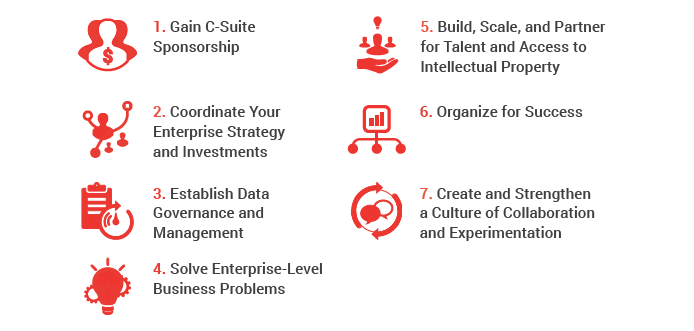
Gain C-Suite Sponsorship
To ensure success in adopting or accelerating analytics or AI across your enterprise, it’s important to provide active sponsorship from all C-suite leaders. These leaders must make cultural adoption a priority to drive progress, and align your assets, investments, and plans to your corporate strategy.
Executive buy-in is key to success.
Executive sponsorship and buy-in is vital for success. The more engaged and bought-in the C-suite is for AI, the better the chance of success in implementing and adopting Analytics and Artificial Intelligence across the enterprise. Ensure that all senior executives engage, actively participate, and “buy-in” to the initiative. It is even more critical as technology, data, complexity, risk, and demand increase. According to McKinsey Global Institute, “strong executive leadership goes hand-in-hand with stronger AI adoption. Respondents from firms that have successfully deployed an AI technology at scale tended to rate C-suite support nearly twice as high as those from companies that had not adopted AI technology.”
It’s not just the job of a CDO, CIO, or CAO—all need to buy-in
It’s not just the job of a single function, the CDO, CIO, and/or CAO if your firm has adopted these roles. If there is no business leader or function that is chartered (and empowered) to spearhead your AI efforts, then you are at risk of falling behind your competitors. Therefore, as a critical first step it is important to establish clear executive ownership for data and analytics (e.g., a CDO and/or CAO). Ensure that the functional leader and their teams are staffed at an appropriate level to drive the transformation strategy and change management needed throughout the enterprise in order to be successful. One-off, independent, or silos of effort will not succeed and may impede progress due to competing strategies, investments or performance objectives
Ensure there is active and engaged sponsorship from all C-suite leaders
Align assets, investments, and plans to enable your corporate strategy
It is important that you are able to drive strategy, resources, investment, and set the tone for the organization and cultural adoption. This includes active engagement and support for BI/AI strategy, assets (both IT and human), investments, and cultural adoption. By contrast, if budget for AI projects, initiatives and/or talent are disbursed throughout the enterprise, or not aligned to enterprise priorities, it will impede progress. Therefore, once you establish commitment at the C-suite level and formalize your strategy, you should also determine how you wish to manage and control your budget and capital throughout the enterprise, particularly if your current landscape consists of competing internal (or external) analytics or AI efforts.
This is not to suggest analytics or AI budgets should not exist throughout the organization but if left unmanaged or not aligned to your enterprise strategy, then the end result may be sub-optimized use of budget, capital and resources, or worse, competing solutions and efforts. The key is to identify the budget and resources, and align them towards your desired outcomes.
Make cultural adoption a priority to remove barriers, obstacles, or blockers
Cultural adoption is perhaps the biggest single challenge and requires the most ops-down leadership to define, communicate, and reinforce the vision/strategy. Be sure to hold the organizational leaders accountable to execute the changes required to drive the transformation. Executive leadership needs to remove barriers, obstacles, or even blockers if required to increase the chance for success.
Champion and communicate wins and progress.
Champion and communicate wins and progress to the broader organization. This will help reinforce the commitment from the top as well as garner support for the transformation. Reward and recognize champions to reinforce and support the behaviors and leadership you need for success. Conversely, a lack of communication and engagement from the top will slow or delay progress by reinforcing that “business as usual” is acceptable.
Coordinate Your Enterprise Strategy and Investments
Make sure you drive strategy and investments that align the C-suite, business, IT, data, and analytics functions or organizations. Success also requires a tops-down, coordinated strategy for IT investments to create or optimize big data solutions, data storage, apps, BI tools, and platform integration.
Have a strategy, plan, and roadmap that aligns business, IT, and analytics.
You need to have an integrated strategy, plan, and roadmap that aligns business, IT, and analytics. This could take the form of a strategic plan and three-year roadmap to align and drive investments in IT, processes, and talent. This roadmap should include your strategy (and timing) for investments in the entire “BI stack” including data storage and governance, big data technology, BI, analytics, and visualization tools and solutions. Without an integrated plan and roadmap, it will be difficult to yield an appropriate ROI on your IT investments.
Create a strong Business-IT partnership to promote progress.
There must be collaboration by all key stakeholders and functions to ensure enterprise benefits. Business-IT partnership is vital for success. It’s not purely IT’s role to implement big data, analytics AI projects, or fix “data problems”. Business leaders must take ownership and responsibility to partner with IT and other functions to drive analytics and AI initiatives. Silos are the enemy of progress.
Big data is part of the “BI stack” and overall solution—not the end- state.
Investing in big data architecture is critical to success, particularly given the explosion in data and data sources like video, chat, Internet of Things, and sensor technology—largely “unstructured” data which complements most legacy structured” data sources like CRM and ERP systems. However, big data solutions should be considered part of the strategy for the “BI stack” of technology from data ingestion, storage, discovery, modeling, analytics/ML, visualization, and mobility.
Big data can provide scalable, fast, and responsive BI and AI solutions to manage both structured and unstructured data. In order to maximize success of your investment in big data, it is equally important to determine what data you will store and make available through an enterprise data warehouse, data lake(s), and high performance memory-resident appliances in order to provide fast, responsive solutions for the business. As discussed later in this white paper, this also requires an effective enterprise data governance capability.
On top of this architecture, you also need to consider what tools are required to enable data exploration and visualization by the business and end-users. There are a number of compelling solutions currently available, and many more being introduced so it is important to strategically assess these solutions against your enterprise requirements and rationalize the tools you require for the given business need or use case. If you have too many BI tools, it can result in inefficiencies, confusion, competition, and a drag on productivity. Ultimately, you may choose several depending on your needs, but the key is not to ignore BI analytics and visualization tools as part of your overall BI architecture strategy and roadmap.
Create or scale a BI system that provides a platform for innovation, analytics, and AI.
Building an enterprise-wide business intelligence or business management system can create a robust big data platform for not only descriptive analytics and reporting, but an effective and fast way to implement predictive analytics solutions, ML, and AI at scale. Build once and share for the benefit of the enterprise is much more effective than building isolated solutions throughout the enterprise. A business management system works well when combined with effective data governance policies and practices governing what data is available in data warehouse(s)/ data lakes, for whom, and how it can be accessed and utilized. Such a platform can actually accelerate innovation and AI by allowing faster identification of end-user best practices or ideas, rapid prototyping, replication, and deployment of best practices, algorithms, and solutions.
An enterprise-wide BI or business management system can accelerate analytics or AI in the enterprise.
On top of this platform, you can readily apply analytics and visualization solutions to drive a scalable, fast, single-source-of-truth solution for the enterprise. It also accelerates analytical discovery by the business since it represents a large volume of trusted, normalized, and relevant data which can be easily accessed and analyzed by the business to determine drivers for success or reasons for under-performance. Ultimately, this will lead to improved ways of evaluating business performance, or introduction of predictive measures and KPIs for success. therefore, in the context of AI, such a platform enables and accelerates the ability to leverage ML and AI faster and more broadly across the enterprise. It is essentially a platform for analytics and AI innovation.
Establish the ability to do rapid prototyping with business and IT teams.
Utilize a prototyping capability or data lab to allow the business to perform rapid testing of new theories, algorithms, or models prior to production. Speed is essential, but so is scalability, security, and maintainability. Rapid prototyping can not only speed solutions to the business, but it can also raise confidence in the final product before it is released which accelerates adoption. You may also wish to create a cross-functional task force encompassing key business leaders with responsibility for chosen use case(s), data, analytics capability, IT, and IP partner(s) to collaborate on critical initiatives utilizing rapid prototyping and agile methodology to quickly move from idea to testing and action. This would also allow you to iterate quickly in enhancements to improve the quality of the product or solution before going into production.
Agile methodology can help accelerate the development of analytics and AI solutions
Agile methodology also needs to be embraced to develop analytics and AI solutions at both speed and scale. Traditional IT development projects take too long, are too rigid, and often do not meet the needs of the business, which do not remain static. You need to have a way to iterate the development process and deliver more frequent “wins” to the business. Otherwise, they will look for solutions elsewhere, which can result in proliferation of “shadow IT”.
Through agile methodology, the business is allowed direct and immediate access to all data within the data warehouse or data lake which precludes the need to acquire, replicate, or export the data into offline tools or systems (in effect creating “shadow IT”). This also allows the business users to shift efforts towards analytics insights and action while ensuring compliance to enterprise data security, privacy, regulatory, risk, and scale considerations.
Data integration, harmonization, and governance are critical to success.
Data integration and consolidation into data warehouses and data lakes are critical enablers for success. Collecting, storing, and providing data is the lifeblood of analytics and AI. Fragmented, “shadow” IT (data disbursed throughout the enterprise in various sources, which are often unsupported and unmanaged) is a significant drag on speed, productivity, and ability to implement enterprise-wide AI solutions. Beyond data collection and integration, data governance is essential to make sense of the data, improve (and maintain) data quality, and manage the access, use, and distribution of the data to enable the enterprise AI strategy.
Be open to strategic partnerships for creative, breakthrough thinking and IP
There is significant investment flowing into AI and related fields. Don’t miss out on the opportunity to partner with leaders in innovation and IP. Strategic partnerships can provide access to leading edge IP and capabilities. However, scalability, security, and integration challenges can slow adoption. As more investment flows into AI, this will become increasingly important and will require the ability to speed integration through open source, API, or cloud integration tools or platforms.
Establish Data Governance and Management
An enterprise-wide data strategy and governance process is a critical enabler for successful analytics and AI implementation. It’s important to recognize how critical, yet challenging, it is to govern and manage data across the enterprise. An effective data governance strategy will help you understand where your data is, what is important, how you need to manage it, and how (and whom) you want to allow access to the data, and then how it will be used.
Data strategy, governance, and management is mandatory for success.
Given the proliferation in data, data sources, and increased end-user demand, along with more intuitive and pervasive “self-service” tools and solutions, the need to have an effective data governance program is becoming even more critical. Without data governance, all of this data will end up in a data warehouse or data lakes and become “data swamps”.
Said another way, proliferation of data and uncontrolled user access can provide full freedom for business users. However, for an enterprise, it can result in confusion, duplication, inefficiencies, and distrust. The appearance of moving quickly on analytics or AI projects will mask the fact that enterprises are absorbed in an internal battle over data access and use, and not allocating the critical assets (people, process, technology) to serve a broader purpose—the organization itself, it’s customers and shareholders.
Establish or scale out data governance and data stewardship across the enterprise.
If there is a weak or nonexistent data governance process or function, then it is critical to create or endorse an organization chartered to address this challenge with appropriate support from the C-suite. The organization or function(s) should include resources committed to manage and improve data collection, accuracy, and use across all critical business functions. The data governance organization must also define and manage data policies, standards, definitions, and manage data quality in order to support an effective analytics and AI strategy while complying with regulatory or legal requirements, privacy, security and other considerations.
Break down data silos to gain access to the data that is most critical, and decide how you want to balance control vs. speed and flexibility in use of the data.
Be maniacal about managing data quality and invest in the tools and rocesses to maintain data quality.
Data quality will directly impact the accuracy of the analytics and AI models and output, and the resulting business decisions, so it is critical to have strategy, tools, and resources dedicated to ensure data accuracy and availability in source systems and data warehouse(s)/lakes. If there are data quality issues, don’t underestimate the criticality to have a strategy and capability to ensure ongoing data quality once you’ve corrected or cleaned up the data challenge(s).
Not all data is equal. Determine what data to tightly control, and what data you wish to make available for self-service, discovery and exploration.
Establish the rules, policies, and controls to govern critical data or KPIs, which must be tightly controlled and distributed or published vs. data you will allow for discovery, exploration, and ad-hoc analysis. This may also change over the life of the data, however, these rules must be strategically determined, managed, and controlled.
Not all data is the same, so it is important to determine what you wish to tightly control as a “single source of truth”, and to comply with privacy, security, risk, or regulatory demands. What data or KPIs are most critical to make decisions, who needs them, how are they delivered, and who “owns” and produces them are a few key questions that need to be answered. Ironically, although tight compliance and governance sounds restrictive, it can actually accelerate innovation and application of predictive analytics at scale. To carry the illustration a bit further, if you have defined the key measurements you need to successfully manage your enterprise (financial or operational), then how powerful is it if you have standardized, normalized, readily available data that you can use to identify trends, variances, business unit or individual performance (and underlying attributes)? It can be argued that your ability to apply analytics solutions increases significantly, including machine learning and ultimately AI solutions.
In parallel, you also need to understand what you will allow for discovery, experimentation, and analysis by the end-users and business, or where you will allow “multiple versions of the truth”. Given the increase in availability of more user-friendly, intuitive analytics and visualization tools, how far will you go to enable “self-service” to create new predictive analytical models or new ways of evaluating the business or creating new business process(es)? Who will you enable, with which datasets, KPIs, and use cases? These are important questions to consider. There is a balance here between being too rigid, yet being too flexible, which underscores the need to have a strategy, organizational capability, process, and adherence to a well-defined data governance model to enable an effective enterprise-wide analytics or AI strategy
- Too much flexibility can result in different or competing versions of the truth, which can create debates, confusion, conflict, and a significant drag on productivity.
- Too much control can result in rigid processes, bureaucracy, slowed or lack of response to the business, and the creation or proliferation of business-led IT solutions (“shadow IT”).
As you make these decisions, it’s important to have a governance process in place that allows you to implement and manage these decisions, including who gets access to what, how much, and what they can do with the data. There are a growing number of vendors and tools in the marketplace that can help enforce and support these decisions (also referred to as “Metadata Management”), including Informatica, Collibra, DATUM, and Global Data Excellence, to name a few
Consider creating a Chief Data Officer (CDO) role and function if you haven’t done so already.
There is a lot of literature on how to organize data management functions, including the role of the CDO. However, the primary message is you need to have an enterprise-wide strategy and effective governance model managed by a function that has the charter and ability to effectively lead and manage the acquisition, quality, dissemination, and use of the data across the enterprise.
Solve Enterprise-Level Business Problems
Identify specific business problems that you can address. Ensure they are strategic and impactful for the broader benefit of the enterprise vs. department or mid-level business problems. Too often, critical or scarce analytics and data science talent is applied to solve minor challenges, automate reporting, or other mundane tasks. It’s vital to align the talented assets and investments to solve critical business problems or opportunities.
The business must lead in the identification and selection of use cases or projects for AI.
Preferably, this should be done by senior executives. Projects or initiatives should be aligned with or enable the corporate strategy. Ideally, the use case or initiative will have a direct and material impact in driving the P&L (cost reduction, top line growth, profitability), better serve customers through reduced cycle time, better quality products and services, and improved customer experience to highlight a few of the most obvious choices.
It must be business-led to ensure commitment and enhance adoption. Depending on where you are in your AI journey, it may be advisable to pursue a “crawl-walk-run” approach where you identify near-term opportunities that may not be as impactful as you may hope (or plan for), but will allow you to test and learn what you are capable of doing, and how to effectively deploy AI. This “roadmap” approach can be a powerful way to build a foundation and rapidly expand your initiatives, and results, as you learn and iteratively improve. I am not suggesting ignoring breakthrough ideas or capabilities, but would suggest focusing on near-term opportunities, building your AI “muscle” in addition to planning for breakthrough capabilities if you are still early in your journey towards adoption.
AI is well suited to optimize internal processes to enhance your operations, improve customer service, or deliver greater financial outcomes for your enterprise.
Ideally, it is a business process that is repeatable, where the business process may be done manually today but can be automated to the point that you can apply machine learning techniques and AI to refine, improve, learn, and strengthen the process. It’s also important to approach these problems initially like experiments where you can identify the critical success factors you want to influence or change and measure the impact of the change in process or hypothesis by implementing a new analytics/ML/AI solution, algorithm, or model. As you do so, you can readily demonstrate the impact of the change in process with agreed-upon measurements, facts, and data which demonstrate the ROI of the solution.
Tie use cases end-to-end, and do not get bogged down in functional silos.
Although you may start with a specific use case like sales forecasting or demand management for supply chain, it’s important to tie these use cases end-to-end, and do not get bogged down in functional silos. You may need to commence with functional solutions, but the key will be how to tie them “end-to-end” for greatest impact. For example, building an outstanding sales forecast model delivers a lot of value to the corporation, but what if you can tie it to your supply chain demand model?
To provide another illustration, marketing and sales must collaborate on the best use of data and insights to improve sales effectiveness, productivity, and results. Marketing data gleaned from customer browsing history, social media sentiment, or contact information can be shared with sales to provide recommendations and leads for follow-through. If the datasets or analytics solutions are not harmonized or integrated, then these will become disparate data points requiring the end user (sales person) to access multiple sources to seek the information, or they may not get the information at all. As a result, integrating these different datasets into a consolidated solution, recommendation, or set of actions for sales will have a much bigger impact than if they stood alone, or worse, competed for attention. For the sales end user, this means a loss in productivity as well as forcing them to decide what is the most appropriate or effective action to take.
Ensure the business problem or use case is strategic and understand its impact to the bottom line.
Don’t underestimate the importance of process engineering skills.
Most business problems that can be automated need to be defined in an “as-is”, “to-be” state where you can apply analytics, ML, and AI solutions to automate, learn, and improve. Experiment and test. Measure before and after. Tweak, modify, and learn. Process engineering skills are critical. Your organization must have the ability to assess current and proposed future state processes that require change.
For example, how do you perform sales forecasting or demand management today? Is it being done on spreadsheets using different formulas, gut instinct, or other means and then manually rolled up? If so, how can you automate the process, embed that into a tool that you can apply ML and AI to in order to learn, improve, and dramatically increase the outcome? At the root of this, you need to have the ability to do process engineering and ultimately, process redesign in addition to the analytics/AI work.
Embed these new AI-driven solutions into decision-making tools and processes.
It’s critical to think about how you can embed these new AI-driven solutions and processes into decision-making or transactional systems. These will yield the greatest impact on the bottom line, customer satisfaction, and productivity. Think about your CRM or sales tools and how you would embed these “recommendations” into your point of quote, transaction, or customer interaction. This can be a powerful differentiator in how you serve customers and how you can improve your P&L.
For illustration, how impactful would it be if you can provide automated recommendations to optimize product configurations or add-on and upsell recommendations at the point of quote or order? Even better, what if these recommendations didn’t require human intervention? Ultimately, integrating AI into workplace processes, decision-making, or transactional tools is the key to long-term success. A redesigned end-to-end process with applied machine learning techniques will not only facilitate faster and better decision-making, enhance business performance and customer experience, but the cost to identify, and deliver on these decisions is dramatically reduced over historically manual (or nonexistent) methods.
Personalized recommendations will accelerate end-user acceptance and adoption.
Generic algorithms and models are generally more advantageous over pure “gut instinct” (although some might argue otherwise). However, the more personalized the recommendation, the better. This also suggests that you should think about how your customers or end-users consume information and how you can deliver your analytics/AI solutions in a relevant, intuitive, and adaptive manner. Man-machine interface is becoming increasingly important as the amount of data, and data-driven solutions multiply. It’s not sufficient to deliver large static reports with hundreds of rows of data. The key is how you convert the data into insights and actions for the individual end-user to act upon.
Build, Scale, and Partner for Talent and Access to Intellectual Property
To be successful, it’s important to develop, partner, or acquire the critical skills you need. It’s well documented that the demand for analytics and data science professionals exceeds the supply of talent, and the gap is increasing.
Ensure you have a strong recruitment process with leading universities and institutions developing analytics talent.
If you have an in-house analytics team, ensure you also have a strong recruitment process and relationships with universities to gain access to critically needed analytics talent. In a highly competitive field like analytics and data science, it goes without saying that you also need to have competitive salaries, benefits, and a well-defined, structured, (and enviable) career path that not only defines upward mobility, but encourages cross-training.
It’s impossible to accelerate creation or adoption of AI without the right talent or partnerships with industry leaders and innovators.
Create or leverage talent development programs to build expertise, skills, and scale.
Once you acquire the talent, it’s also important to retain the talent and expertise. This means investing in talent retention or development programs that allow you to quickly ramp new hires, provide advanced skills, and mitigate the impact of turnover. Given the high demand, and high attrition of talent in this space, a rigorous talent development program can help reduce turnover while accelerating the use of critical knowledge or skills to be successful – whether “hard” or “soft”.
Development programs should also bridge the gap between the “science” (e.g., predictive analytics, machine learning, deep learning) of analytics and data science and the “art”. Deep business or domain knowledge is needed to be most successful, or ensure the analyst is embedded in the business. Don’t ignore the importance of soft skills like verbal and written communications, including “storytelling”. Invest and develop skills in these areas.
Utilize a knowledge management platform and tools to share models and best practices.
This will help provide faster, proven solutions to end-users and customers. Invest or create knowledge management systems or platforms, and tools to share analytics models, automate data ingestion, etc. This will help build scale in your analytics organization, speed solutions to the business, and reduce “re-work” or duplication. More time can be spent on new techniques, or insights derived from the data.
Build the talent and skills needed in complementary functions to be successful.
Don’t overlook the importance of process engineers, IT infrastructure, developers, and project managers. All functions and skills are required in most enterprises to build robust, sustainable AI solutions. If these skills are lacking, it will be difficult to quickly deploy analytics solutions into production.
Partner with firms like Fractal Analytics to gain access to critical expertise, skills, and IP.
This will help you extend or complement your in-house capabilities to move faster to meet internal demand. It will help you obtain access to the talent and proven knowledge, skills, and IP solutions necessary to understand the business problem, build the analytics/ML solutions needed to address the business problem, and access leading-edge IP and knowledge from their deep bench of experts and investments in AI. They also have the ability to provide best practices or solutions from other industries or use cases that may accelerate your own efforts. Given the rapid increase in investments in artificial intelligence, partnering with industry thought leaders can also help keep you current on new and emerging technology and IP that can further accelerate your AI initiatives.
Organize for Success
Choosing the right organizational model is also an important factor in accelerating adoption of analytics, machine learning, or AI solutions. There are benefits and drawbacks to choosing a fragmented analytics team vs. one that is centralized in the organization. Consider using a hybrid model to combine the best of both worlds.
Highly dispersed or fragmented analytics talent can create challenges in driving enterprise AI
If your talent is highly fragmented or staffed in department and/or mid-level functions, it will be extremely difficult to build enterprise-wide solutions. Analytics or AI solutions being developed in fragmented manner may be interesting, “sexy”, or possibly breakthrough in some respects, but do they solve the most critical business problems or challenges? Are they aligned or are there competing solutions being developed? Is the work effort strategic, or tactical, and are you leveraging the critical and scarce talent in the most effective manner to achieve your goals? De-centralized analytics organizations may result in some of the following challenges:
- Excessive focus on depart or tactical objectives, not strategic.
- Internal competition for funding, tools, talent, and control.
- Proliferation of BI/Analytics tools or solutions.
- Limited or inability to apply predictive analytics at scale.
- Difficult or impossible to move or develop talent across the organization.
On the other hand, highly centralized analytics organizations run the risk of being irrelevant.
By contrast, highly centralized analytics organizations run the risk of being irrelevant or lack the business knowledge to be successful. Centralized analytics teams can provide scale and the ability to quickly understand, share, and leverage best practices, tools, and methodology which are constantly and rapidly evolving. Characteristics of an overly centralized analytics organization may include:
- Too rigid or slow in delivering analytics/AI solutions to the business.
- Disproportionate focus on the science of data and analytics vs. the business impact or outcome.
- Lack of business knowledge resulting in ineffective or irrelevant solutions.
- May result in increased growth or proliferation in de-centralized analytics talent
A well-defined and effective organizational model can accelerate the adoption of analytics and AI solutions in the enterprise.
Consider a hybrid model to combine the best of both worlds.
Therefore, whether you build or partner to acquire your analytics expertise, you must carefully consider how to organize your talent in a way that allows for both expertise and scale in the tools, processes, and techniques of analytics and data science (the “science”), yet also provide for close alignment and understanding of the business and business problems that need to be solved (the “art”)
- Analysts or data scientists must be close to, if not embedded in, the businesses they support in order to better understand the business challenges or processes that need to be improved. Don’t “throw the challenge over the fence and hope for the best”.
- A model that provides the best of both worlds is the “hybrid” or “hub-and-spoke” model. There are different ways to implement these hybrid models and determine where the resources are placed, and who manages them. Overall, this hybrid approach has many advantages over the decentralized or centralized functional models.
No matter which model you choose, it’s ideal to have analytics talent remain close to the business. The more they learn and know about the business, the more effective the solutions will be. Conversely, the more remote (physically, intellectually, organizationally) your analytics talent is from the business, the less successful you will be.
Create and Strengthen a Culture of Collaboration and Experimentation
It’s also important to build a culture to collaborate, experiment, and innovate. Build a roadmap that delivers early and frequent “wins”, and communicate the progress and wins throughout the enterprise to inform, “de-mystify”, and rally support for your AI initiatives.
Remember that AI is a journey.
It’s a journey. Be willing to fail, learn quickly, adapt, and test again. The organization will learn. As you do so, collectively the organization will also learn how to better utilize analytics and AI to solve more complex questions or problems, and learn how to be more proactive in applying the solutions and outputs.
Enable collaboration and teamwork
Provide incentives, KPIs, or metrics to encourage coordination across functions like business, operations, IT, and analytics to work together. Engage the right subject matter experts. AI is not a problem nor solution that is solely in the realm of data scientists or IT. You need the operational, business, and technical expertise to ensure that the analytic outputs solve the business problem or challenge. It requires effective collaboration by business, operations, analytics, and IT experts to solve complex challenges and design, deploy, optimize, and maintain solutions leveraging ML and AI
Don’t underestimate the challenge or importance of cultural acceptance and adoption.
Identify internal champions, thought leaders, and change agents to help drive cultural awareness and adoption.
Identify and build champions or change agents who can help drive the cultural awareness and adoption needed to gain traction. Ensure they are recognized as key leaders and operate at a level or in a function that is strategic enough to make an impact. They are instrumental in achieving and communicating early wins and gaining buy-in from their peers, co-workers, and team members. Champions can also provide honest and frank feedback which can help improve the solutions you deliver which can ultimately accelerate broader adoption
Build your roadmap to yield early wins and successes to increase confidence and momentum.
Build your projects or roadmap in a manner to yield early wins or successes. This will enhance confidence and demonstrate the value or impact of the investments in big data, analytics, and AI. If you are successful in doing so, you will gain further buy-in from the sponsoring business or executives to invest, move faster, and more broadly if they understand the value and impact to the corporation.
Communicate early wins and successes to provide encouragement and support for the journey.
Communicate the progress throughout the enterprise to garner broader support and momentum for further investments, collaboration, and buy-in.Communications should start with the CEO in order to instill the importance throughout the enterprise. Change management is paramount to success in implementing AI in the enterprise in order to offset resistance, fear, uncertainty, or questions over the ROI of AI, and potential impact to the organization.
Be aware of obstacles, roadblocks or even “blockers”, and take appropriate action.
Internal competition for talent, data, control, or even “storytelling” work against the greater good. The more internal silos and competition you have, the slower you will be in adoption and gaining the benefits of analytics or AI to benefit the enterprise.
Determine an objective way to recognize the impact of the investments being made and impact to the bottom line.
Speaking of ROI, determine a way to equitably measure the impact of analytics or AI vs. the business decision or action. The impact of analytics (or AI) may be “watered down” if the value of the work is hidden, understated, or misunderstood. Alternatively, proclaiming excessive impact due to the analytics output vs. the business action can result in distrust.
The Next AI Conversation
In closing, there are many critical elements required to adopt or accelerate analytics and AI solutions in an enterprise. In an ideal state, these strategic elements work in an orchestrated fashion to enhance the chance for success. This doesn’t suggest you cannot be successful if all of these elements are not in place, or mature throughout the organization. However, senior executives and leaders who utilize these strategies will be more successful in implementing or accelerating their analytics and AI initiatives. Ultimately, enterprises which make AI a strategic priority or imperative will create a competitive advantage in the marketplace.
The Next Step
Contact us at Fractal Analytics to have a conversation to see how we can help you in your journey.
About Author
Doug provides advisory services to help advance Fractal Analytics’ capabilities, services, and offerings to empower enterprise clients.
Doug held various leadership roles at Dell for more than 19 years. In his most recent role, he was responsible for providing global data, reporting, and analytics services to support Dell’s sales, marketing, finance, services, e-commerce, and operations business units. He also partnered with IT to launch Dell’s first enterprise-wide big data business intelligence solution to create a platform that significantly improved enterprise level descriptive analytics while enabling and accelerating predictive analytics at global scale
In his prior role at Dell, Doug was the Vice President of Dell Services, where he was responsible for delivering data center and desktop managed services and outsourcing engagements for Dell customers worldwide. His responsibilities included ownership for a $1.5B P & L, solution design and delivery, and global leadership of over 6,000 professionals. Prior to that, he held several senior executive roles in Dell Services where he led growth and scaling of Dell’s enterprise and global service capabilities to serve customers in all segments and regions. Throughout his tenure at Dell, Doug was also a champion and leader for diversity, STEM education for girls, and an advocate for women in technology leadership
Doug leverages his passion, knowledge, and experience to help Fractal Analytics and clients accelerate the use, adoption, and value creation with data, analytics, and AI in the enterprise.
Most B2B buyers rely on the ‘voice of the web’ to evaluate sellers, creating a footprint of data on buyers’ interests. To drive sales, companies must use these data trails to understand buyers’ needs, identify the right leads, and reach out to them on their terms with timely and contextually relevant information and offers.
With AI and analytics, your company can understand buyer behavior—before, during, and after the purchase—to drive smart interventions at key stages of the buying journey. You can use analytics on browser behavior to identify and prioritize high-quality leads. You can leverage AI to identify next best actions and deliver personalized communications to drive sales.
That’s how data can help your company take control of the B2B buying journey. It will empower your marketing, sales, and product teams to work together to influence sales in your favor, all while reducing sales cycle times.
Companies with e-commerce sites must deliver personalized experiences to engage customers and guide them to take the right actions. Digital personalization is the key to tailoring web experiences to visitors’ unique preferences and needs. With data-driven experiences, you’ll give each customer the right content and recommendations to increase their chances of making a purchase. Your customers will discover relevant new products to drive more conversions and loyalty for your business.
Take personalization to the next level with advance technology. When user bases and product sets are large, use big data platforms to capture highly granular behavior. Optimize content in real-time with AI. Collaboratively filter content to tailor experiences using sophisticated algorithms.
Tailor experiences even when visitors are anonymous and data is limited. By taking limited data captured from anonymous visitors, then integrating it with third-party data and online behavior from known customers, you can deliver personalized experiences for anonymous visitors.
It’s time for payers to experience a better way to identify anomalous claims. The common process to identify anomalies is business-rules-driven, manual intensive, applied in a post-pay scenario and focuses mainly on known patterns, thus solving the problem partially.
Applying advanced analytics and looking for opportunities beyond overpaid dollars, such as better utilization management, plan design changes and network optimization, helps detect hundreds of unknown anomalies.
Payers can use the new analytical framework to drive up to $50M additional impact within the first year of operationalization — by increasingly focusing on unknown anomalies.
Get better results by:
- Applying predictive analytics and AI to better prioritize claims for SIU review
- Automating the entire anomaly identification process
- Creating a visual solution suite to help identify anomalies, track alerts, and measure the impact of interventions
- Delivering significant impact in both post-pay and pre-pay scenarios
The significant ROI in initial year/s enables payers to self-fund a suite of more advanced AI-driven scalable solutions to keep identifying and tracking anomalies, and improving recoveries from the flagged claims.
With an innovative analytical framework applied on external data, payers can enhance the performance of existing rating modifiers to inform additional risk. Health insurers can leverage new signals from consumer data to predict claims experience to deliver an improved risk assessment process. These new signals include factors indicating buying behavior patterns, socio economic and financial statuses and health interests.
The enhanced rating modifier can help payers create an R-squared lift of up to 15%.
This lift is over and above claims experience typically informed by internal risk factors that payers already assess—such as age, gender, and location.
A few external indicators of additional risk informed by claims experience can include data on economic stability, usage of mobile phones, prime time television usage, smoking, community engagements, derogatory records, and dwelling status.
Analytics helps insurers:
- Identify key drivers of customer satisfaction and effort
- Increase retention via proactive engagement of those most likely to leave
- Prioritize the most valuable customers
Analytics and automation help insurers:
- Reduce cost of operations
- Optimize resources and time of operations
- Automate key operational processes
Analytics helps insurers:
- Reduce cost per claim
- Pay out the correct amount
- Enhance claims experience
- Set the right reserves using better severity estimation
- Improve fraud detection
Analytics helps insurers:
- Reduce underwriting time and expenses
- Determine the optimal pricing structure to maximize profitability
- Build better pricing frameworks and reduce leakage
- Identify the right cases for straight through processing
Analytics helps insurers:
- Reduce acquisition costs by channel and segment
- Use the right channels to optimize the customer experience
- Enable greater cross-selling and up-selling opportunities through sending the right information to agencies/brokers
- Identify and promote the most profitable agencies
Analytics helps insurers:
- Reduce customer acquisition costs through more efficient and effective targeting and content
- Drive sales through personalized prospect and customer interactions with the most relevant offerings
- Develop and institutionalize the next level of customer segmentation
Enable better and faster resource allocation decisions.
In today’s marketing environment, CPG manufacturers are having to manage shifts in consumer behaviors and disruptive forces in digital marketing, e-commerce, and retail. In this zero-based-budgeting environment, driving efficient growth requires data-driven planning and holistic marketing resource allocation across traditional and digital channels.
Our Integrated Marketing Effectiveness solutions take a holistic approach to improving the productivity of CPG companies’ marketing resources, enabling faster decision-making in a dynamic environment.
Analytics answer critical questions for CPGs:
- How do I drive efficient growth for my brands and portfolio through optimized allocation of marketing resources?
- How should I invest across countries, accounting for stable demand vs. emerging demand markets?
- How do I re-optimize my marketing resources to defend against marketplace changes?
- How do I balance investment across various traditional and digital channels? What is the impact of owned, earned, and paid media?
- How do various marketing channels interact and reinforce each other? What is the ‘true’ ROI of each channel, after accounting for these interactions?
- What is the impact of brand equity on baseline sales, and what are the key components of brand equity that most impact sales?
- What are the creatives and messages that resonate most with the consumer?
- What are the drivers and marketing response by consumer segment?
These insights help you gain:
- A holistic view of brand and portfolio drivers across traditional and digital channels
- Powerful insights and activation, not just data
- ‘True’ ROI calibration that takes into account the effects of interactions
- Deeper understanding of baseline utilizing brand equity, macro, and uncontrollable factors
- Customized, ‘open-box’ models to fit business issues
- Faster analytics to enable speed-to-activation
- AI-enabled data platform to easily accept and digest data from various sources and formats
- ‘Always On’ platform to keep the models ‘live’ and activated with the latest data—so that business planning can be done in real-time
- Easy-to-use simulation and optimization tools
- Deeper dives into message optimization
- The ability to go deeper with consumer segments
Integrated Marketing Effectiveness in action
A leading specialty goods company wanted to understand the productivity and ROI of marketing channels in order to continue growing and overcome industry headwinds. The company had fragmented data across multiple platforms and wanted to have a comprehensive view of both online and offline channels for their flagship brands. An additional complication was the high seasonality of the category, with majority of sales occurring during the holiday season.
To solve the company’s challenges, we built an analytics-ready data platform by collecting data from multiple sources and formats, enabling ongoing modelling and business understanding. We overcame challenges in data quality and frequency to build robust marketing mix models to understand the drivers of the brands’ and portfolio sales, and deliver optimal spend recommendations. Our analysis helped build a business case for continuing well-performing channels while divesting low performing areas—thus unlocking funds to drive growth. We developed strategies on how to optimize spends during the holiday season, and the right mix of messages for the best performance. We delivered continuous insights and optimization through the deployment of simulation and optimization tools, and with the help of our continuous modelling platform.
As a result of the engagement, the company gained:
- Robust analytical models and simulation tools that helped add rigor to the company’s business planning and marketing resource allocation processes.
- Data integration from various sources that aided in a unified view of their business, serving as a foundational platform for analytics.
- Media spend recommendations (developed across all channels) that resulted in increased ROI for its flagship brand.
Gain insights to optimize sales across channels.
With demanding consumers and omnichannel experiences being the new normal, it is imperative for CPG organizations to have a strong sales strategy that can optimize sales across a myriad of channels and help maintain delivery and service levels while keeping costs under control. Fractal helps companies drive sales function transformation by combining the art of sales and the science of decision-making. We bring into play strong insights-driven strategy consulting to help set up sales strategies and behavioral sciences to enable successful execution and transformation.
We help our clients increase revenues and reduce the overall cost to serve by digitizing the entire value chain for high-speed, actionable insights that include:
- Digitizing market mapping and infusing new data signals in data deficient markets
- Digitizing store for store clustering, SKU recommendations, and merchandising plans
- Digitizing promotions and stores for in-store execution and trade promotions optimization
- Digitizing the sales force and equipping them with insights and recommendations dynamically
Sales function transformation in action
A global CPG company wanted to become the market leader in distributive trade channels (highest market share) across emerging markets. It wanted to understand the channel better, generate penetrative insights on retail stores and their shopper behavior, drive optimal pricing and promotion decisions, and ultimately, achieve profitable growth.
Fractal helped create a roadmap that helped the company work comprehensively on each of the touch points within the sales environment—namely retail stores, sales team, distributor trade, and trade marketing organization—making it a win-win for all stakeholders. The approach included net revenue management, sales force incentivization, reporting, and tertiary sales information.
Improve sales and operations results with analytics.
For CPG companies, the ability to accurately predict product demand is critical to all parts of the value chain-from sales to marketing to manufacturing. Yet, forecasting is a major pain point for most companies. In addition to technical complexity, it is arguably the most politically charged area of analytics. Fractal’s Demand Forecasting Solutions enable companies to address these challenges by offering a transparent, flexible solution that can be fully customized to a company’s needs.
Fractal helps CPG companies through:
- Highly-customized tools that can be adapted to reflect specific business models and market conditions
- Integration with existing systems and data sources
- A robust statistical methodology for existing and new products
- AI-assisted technology that provides an enhanced approach for new product forecasting
- Scale to provide full coverage across multiple categories and markets
Fractal can help CPG companies realize many benefits, including:
- Increase accuracy levels 15%-35% depending on the business model and availability of sales drivers’ data
- Lower inventory costs and improve service levels by increasing accuracy to drive reductions in inventory costs and drive high ROI and service levels
- Reduce turnaround time where the forecasting cycle decreases three to four times compared to intuition-based approaches, leveraging automation that allows demand planners to focus on value-added activities
- Standardized and transparent processes that minimize human error through enhanced automation, allowing the organization to cover more categories and drive deeper insights with no increase in estimators
- Scalability and uniformity across markets
S&OP in action
A global personal care company with a highly complex business model and direct sales force had been struggling for years with low forecast accuracy. The company used a highly manual forecasting process, relying on the experience and intuitions of planners. Rapid product turnover resulted in many outliers, with either excess unsold inventory or shortages and missed sales.
Fractal’s demand forecasting solution was adapted to the client’s business model, accounting for specific drivers such as field promotions, bundles and co-promoted items, and a module for new product estimation. The solution resulted in a 15- point increase in forecast accuracy, significant increases in speed and efficiency, a 5 percent reduction of inventory costs, and a 10 percent improvement in service levels.
Deploy data-driven revenue growth and management capabilities.
With many categories and markets reaching saturation points, revenue growth is becoming increasingly challenging to find. In this new reality, demand is no longer growing by leaps and bounds, so CPG firms need to shift their growth strategies from relying on a few large opportunities to finding and tapping multiple smaller pockets of growth across products and accounts.
Our integrated Revenue Management solutions help CPG clients to do just that: quickly and efficiently examine multiple execution levers to identify growth and profitability opportunities from product portfolio, pricing, and promotion strategies.
We help CPGs address critical business questions:
- Where are pricing opportunities across my brands, SKUs, and accounts?
- Where am I spending too much on promotions, discounting too deeply or too often?
- Are there any opportunities to improve my price and size architecture?
- Can I improve profitability through better assortment and more optimal use of shelf space?
- What actions should we take to capture identified value?
Our Revenue Management solutions help CPGs realize key benefits:
- An integrated view combining multiple data sources
- Highly visual and intuitive interfaces
- A quick, efficient, and granular approach that delivers results faster, at an actionable level, and on regular basis
- Different solution tiers to address markets and categories of varying size and complexity
- Ongoing support
Revenue Management in action
A global personal-care company was looking for a standardized RGM solution to cover most of their markets and categories. Its challenges included a lack of integrated and accessible data, a lack of uniformity in how markets viewed RM, and different levels of market sophistication.
Fractal’s solution addressed these challenges through offering a standardized analytical framework, identifying and connecting key data sources to enable quick updates. Together, we delivered analysis through standardized and easy to understand visual stories. A tiered approach was used, with initially a ‘light’ version for smaller markets and a ‘full’ version for larger markets.
Gain the insights that give you a competitive edge.
Leaders in CPG and other industries must make quick, substantive changes in their operations and organizations to realize the business benefits of a high-performing, advanced analytics and AI environment. Fractal’s market leading approach can help you develop and transform Analytics and AI functions to create sustainable growth and a competitive advantage for your organization.
We provide a proven insight, analytics and AI value chain model with Analytics IQ and Analytics Value metrics to benchmark your organization’s decision-making process against best in class companies. We then help you develop a holistic Analytics/AI transformation strategy that includes people, process, technology, and capabilities. We have been entrusted with transforming top Fortune 500 insight and analytic functions, improving decision-making by helping clients do more with less, and getting to decisions faster.
Fractal helps CPG, Pharma and other industries address critical questions about their businesses:
- How can we act as thought leaders to our stakeholders, providing them with the strategic advice about their internal decision-making processes?
- How do we leverage new data and analytic capabilities to better understand the consumer and the marketplace to improve decision-making?
- How do we change the way we deliver our work to become more relevant, increasing the activation rate of our work?
- How should internal decisions be made in most efficient and effective way to drive a real change in how we do business every day?
- What should be the most optimum Analytics/AI operating model, organization, processes to enable all enterprise decisions? How we should educate and train internal teams to leverage analytics/AI in their day to day work?
Analytics transformation in action
A global, $50B+ CPG hired Fractal to develop a global analytics strategy and implementation path. Leveraging our proprietary IAVC framework, we benchmarked the company’s capabilities against other leading CPG firms, identifying strengths, gaps, and performance drivers. Combining these results with internal stakeholder requirements, we created a decision-first framework. We anchored the analytic strategy and capability development around improving quality and activation of key, high value-add decisions.
Drive future growth by uncovering new strategic opportunities.
Leaders in all industries must capitalize on intelligent, data and foresight-driven growth strategies in order to succeed in a competitive market. Fractal’s forward-looking approach can help you uncover future growth opportunities, size future demand, and develop optimum growth strategies to succeed in tomorrow’s marketplace. Our growth foresight analytics (Growth4sight Analytics) have been proven over time to deliver consistently accurate results that help clients realize unparalleled growth opportunities.
Growth4sight Analytics answer critical questions about your business:
- How will consumer’s needs and behaviors change in future?
- Where is the market’s future growth and what factors will drive it?
- What are our strategic opportunities? Where are the biggest pockets of growth?
- Where will my growth come from if I maintain my current portfolio vs. expand into new areas?
- Which opportunities should I prioritize? How should we optimally execute against these opportunities?
These insights help you:
- Predict and “foresight” future growth opportunities
- Foresight how consumers’ needs, behaviors and trends will change in future
- Develop the most optimum growth scenarios to meet growth targets with maximum predictability and efficiency
- Select the optimum execution strategy to maximumly realize these growth opportunities
Growth strategy in action
A global beverage company was looking for a significant increase in growth across 19 countries within the next five years. It wanted to understand where the growth would come from, including new and existing product categories as well as consumer needs. It also wanted to understand—once the growth strategy was defined—how the company should execute to optimally reach that growth.
Together with Fractal, the company developed a foresight-based growth framework to identify future growth opportunities and develop an optimum execution model and provide sustainable support to ensure the growth is realized. The company utilized best-in-class blended analytics-driven consulting to assess trend-based-driven 2020 growth of need states and categories in markets.
The association with Fractal has been an enriching one indeed. Fractal provided VIDYA with the flexibility in terms of presenting program funding options and the relationship was always mutually fulfilling one. The Fractal volunteers were always dedicated and very humble. The feedback that we have received during the course of this association has been very valuable and has helped us improve our reporting and program delivery.
Deliver automated and production-grade solutions that work towards reducing human intervention.
Turn dark data, such as text, images, video, and speech, into structured data with human-caliber quality at machine-caliber scale.
Perform large-scale and high-speed analytics on vast volumes of data to generate immediate insights.
Use distributed compute capacity to drive new advances in artificial intelligence.
Can you detect and identify suspicious person in an image or video? Can you track people and log their attendance using their face data? Our deep learning based face recognition algorithm can detect and identify faces in real time which can be applied to many real life application including security surveillance, attendance management, criminal identification etc. The solution can be extended to extract sentiments (happy, sad, angry etc.) and demographic information (age, gender etc.) attendance management, criminal identification etc. The solution can be extended to extract sentiments (happy, sad, angry etc.) and demographic information (age, gender etc.)
Reveal valuable insights by accurately recognizing objects in images and videos. From surveilling people in real-time at events to detecting if products are in the right place in shopping aisles, AI can drive value in many ways.
Create in-depth analyses by placing image objects into relevant segments. AI based algorithms can help insurers analyze home and auto damage to create more accurate claims for customers.
Understand customer behavior by identifying their actions from video—both in-store and in real-time. AI helps reveal how customers interact with products and brands to drive better experiences.
Get immediate insights to take action when it matters most. AI algorithms enable real-time processing for a variety of valuable uses, such as face recognition.
Our love for all things earth friendly, Indian and innovative is what drives us to do what we do at The Giving Tree. We help our clients feel special by creating bespoke gifts that speak the language of appreciation and warmth. We had an opportunity to participate in the Christmas Bazaar at Fractal Analytics last month. In this time of online shopping and a huge influx of machine made cheap products from outside the country, Fractals’ initiative to go the earth friendly way and bring together a plethora of handmade products together is a great sign. This CSR has been in a direction that empowers us to showcase our products to an appreciative audience and that is the biggest thrill for entrepreneurs like us.
- Empowering women to augment their family income, increase their share of family income or increase their savings towards desired goals almost always benefits an entire family unit. At Fractal, we actively encourage procurement of company supplies, mementoes and giveaways from collectives run by women for the upliftment of the economically disadvantaged. Regular CSR bazaars held at various office locations encourage lady artisans, entrepreneurs to exhibit and connect with potential customers amongst our colleagues. Some such collectives have included women weavers from Madhya Pradesh, sustainable textile and stationery manufacturers from Karnataka, upcycled paper product manufacturers from Tamil Nadu. The Fractal CSR bazaars are popular and anticipated events that often symbolize the beginning of shopping for festive occasions amongst Fractal colleagues.
- Fractal’s work with its CSR partners also sees it contribute towards skill enhancement and financial inclusion of lady employees in the educational institutions supported by Fractal.
DEEDS Vision is to make a better life for the Deaf & Mission is to make 20000 Deaf financially self reliant and contributors in society by the end of this decade. In pursuance of our vision and mission, we have set up many skill training projects in Mumbai which are conducted free for the Deaf. We take part in Exhibitions and CSR Bazaars because this is one major way of reaching out to the discerning public on what DEEDS is all about and the products that are exhibited and sold in these Bazaars are made by the Deaf. The encouragement and interest that we receive at Bazaars like yours gives us and the Deaf individuals adequate motivation and enthusiasm to do even better.
Being a woman, life expects so much more than managing a home round the clock, or balancing a work – home life. There are new solutions each day to make our lives easier, yet the space of meals lacks a product which supports our inherent culture of eating fresh. Burgundy Box is a bid to create a product line which promotes eating fresh and healthy, be it from our ready to eat line or from our innovative meal kits, empowering women to serve fresh and healthy meals for their families with utmost convenience. It was helpful for us to showcase and explain our products at a forum like the Fractal CSR Bazaar. We hope this can help your employees as well. Thank you so much for your support.
We felt supported by Fractal’s contribution and we would also like to do such activity anytime. It was a great experience sharing nature conservation activities with Fractal executive. They were supportive and wanted to know about BNHS conservation work. We had also spoken regarding small ideas, on how they can help saving nature.
Gavin Patterson was appointed President & Chief Revenue Officer, Salesforce on August 1, 2020. He is responsible for worldwide sales and distribution of Salesforce products and services. Patterson joined Salesforce in August 2019 and served as Chairman of EMEA Advisory Board and President and CEO International.
Prior to Salesforce, Patterson served as Chief Executive of BT Group from 2013-19 and a board director from 2008-19. During his tenure at BT, he completed the UK rollout of the superfast fibre and started the deployment ultrafast fibre. He led the £15billion acquisition of EE, launched BT Sport, expanded BT’s cyber security practice and championed BT’s social purpose agenda. He joined BT in 2004 as MD Consumer and joined the board as CEO BT Retail in 2008. Prior to BT, he spent four years at Virgin Media latterly as MD Consumer and nine years at Procter & Gamble in various brand management and marketing roles.
Patterson is Chairman of Business in the Community, a Non-Executive Director at Elixirr Consulting, the APAX backed AI business Fractal and EQT backed Delta Fiber. He served on many boards including British Airways plc and as a Trustee at The British Museum and acting as an advisor for many tech start-ups. He graduated from Cambridge University with an MEng in Chemical Engineering.
Hosting on September 28-29 in Chicago at the Swissotel Chicago. This private, invitation-only event comprised senior executive analytics thought leaders among Fractal’s strategic clients, representing some of the world’s most valued brands representing, in aggregate, over $600 billion of annual revenue.Hosting on September 28-29 in Chicago at the Swissotel Chicago.
Fractal hosted our 4th annual Client Advisory Board event on September 28-29 in Chicago at the Swissotel Chicago. This private, invitation-only event comprised senior executive analytics thought leaders among Fractal’s strategic clients, representing some of the world’s most valued brands representing, in aggregate, over $600 billion of annual revenue.
The event content was comprised of a keynotes, a panel and workshops with the following themes:
- Shared key trends in analytics and artificial intelligence (AI) and how these approaches are transforming our world
- Revealed new applications of Deep Learning (form of AI) among Member industries to shift from gut decisions to algorithms that
drive faster, more accurate, and more effective decisions - Share their views on the key drivers of analytics success within Member enterprises including how to organize and which people
are needed, the importance of data acquisition, influencing the C-Suite to drive the analytics mandate, and influencing business
users to adopt analytics, by considering: - Members shared case studies on successful analytics implementations and lessons learned
- Discussed the key considerations in building an analytics roadmap and adoption plan
Our analysts used advanced tools and text-mining techniques such as pattern matching, phonetic matching and approximate string matching to develop an algorithm for de-duplicating records and identifying unique customers and households.
We recommended a scorecard-based approach for extending credit, to score retailers’ behavior on PAE business transactions.
Our analysts used advanced tools and text-mining techniques such as pattern matching, phonetic matching and approximate string matching to develop an algorithm for de-duplicating records and identifying unique customers and households.
The more technology advances, the more it’s integrated into our daily lives. Even as you read this article, I’d venture a guess that you have several Internet-connected devices within arm’s reach. As we continue down these innovative pathways, we’ll continue to see technology become more important to our day-to-day living. The lines between what we do online and in real life will begin to blur. And as people change their behaviors, marketers, salespeople, and customer support reps will need to react.
Jerry leads Customer Genomics and Trial Run product offerings at Fractal Analytics.
Prior to this, he was the Chief Strategy Officer of Olenick & Associates, the largest US-Headquartered software quality firm, focused on building the entire go-to-market strategy. Prior to Olenick, he served as the CEO of EIC Solutions, a niche electronics company that was transformed into an Internet marketing expert. Jerry executed a management buyout of NSTL, Inc. and built that company into the world leader of testing and certification of mobile software applications, prior to selling to a strategic buyer. Prior to NSTL, he served as Manager, Corporate Development, Advanta, Corp. and as a Senior Consultant in the Financial Advisory Services group of Coopers & Lybrand.
He has an MBA, Villanova University, Villanova, PA; BS, Finance, Drexel University, Philadelphia, PA.
Natwar is the business head of Cuddle.ai – AI based personal analyst for business professionals.
Natwar led Fractal as part of its leadership team through multiple growth stages over the past decade. He led the data-science and technology agenda for Fractal & its clients, built & grew CPG practice amongst others, conceptualized & delivered analytics technologies like Concordia & Trial Run. He was instrumental in building a top-notch data-science team providing the right foundation for the growth. Natwar is now building Cuddle.ai – a wholly owned subsidiary of Fractal Analytics – to bring the power of AI to the world of BI by building the world’s most intelligent BI platform.
He has an MBA, Indian Institute of Management (IIM), Calcutta and B.Tech in Mechanical Engineering, Indian Institute of Technology (IIT), Bombay.
- Access to innovative thinking and ideas

- Joint product development

- Access to technical support




- Validate software pre-release


- Joint business planning

- Joint marketing planning


- Account management




- Pre-sales assistance



- Sales tools and resources




- Extend current capabilities




- Offer complementary services



- Offer new solutions

- Provide value-add solutions



- Provide additional consulting


- Use Fractal logo




- Access partner portal (future)




- Access case studies




- List on partner website




- Attend partner events




- Target new clients



- Open new markets


- Get sales referrals



- Accrue marketing funds


Solution Providers use Fractal to provide “behind-the-scenes” business analytic services to current or new clients. These include reporting and dashboards, problem-solving requiring varying degrees of analytics expertise focusing on topics like business health, program and ROI analytics, consumer or customer engagement, as well as on-going maintenance support.
Service Providers are Agencies and Marketing Services companies who work with Fractal to target the right customers via digital interactions. What’s of utmost importance is to optimize marketing budgets, construct an appropriate test and learn environment and predict outcomes accurately.
Technology Partners provide complementary technologies to Fractal’s services. These partners enhance Fractal’s analytics services and include data intelligence, visualization tools, hardware and software providers.
Global Partners collaborate to develop and offer Business Intelligence offerings to mutual clients and prospects. These partners are innovation-focused, solution-driven and have high interdependencies with Fractal.
Mr. Gulu Mirchandani is the Founder Chairman of the Onida Group. The flagship company of the Onida Group is MIRC Electronics. He is also Co-founder Chairman of Akasaka Electronics and Iwai Electronics. He was appointed as the President of Consumer Electronics & TV Manufacturer Association (CETMA) for two consecutive years in 1992 & 1994.
He was also the Chairman of the Bombay chapter of the World Presidents’ Organisation (WPO). He is also on the Boards of VIP Industries Limited and KEC International Limited among others. He is an alumnus of BITS Pilani and holds a degree in BE (Mechanical).
Karenann Terrell is the former Chief Digital and Technology Officer for GlaxoSmithKline. Her responsibilities at GSK included leadership for all information technology as well as Data, Analytics and Digital Transformation (GSK split into 2 legal entities- a BioPharma company and a separate Consumer Health Company which went public as Haleon in July of 2022) Karenann was previously the chief information officer for Walmart from 2010 to March 2017. Her responsibility for the global Walmart Technology portfolio included both Information Systems Division(ISD) and Global Back Office Solutions. Terrell previously served as chief information officer of Baxter International, Inc., where she was responsible for the company’s global IT function, supporting businesses worldwide in bio-tech, medical devices and pharmaceuticals and was chief information officer in Daimler Chrysler where she had total technology responsibility for the Chrysler Group and Mercedes-Benz Americas. She began her career with General Motors as an electrical engineer, where her responsibilities included manufacturing and product engineering for the Chevrolet and Cadillac brands as well as the Onstar division.
Karenann has been a transformational technology leader in the Automotive, Pharma, and Retail industries where she drove technology modernization and transformed technology stacks which allowed business model transformation for the companies in which she worked. Her technology remit included responsibility for all cyber security efforts globally.
Her capabilities include deep knowledge regarding technology engineering and support for global supply chains, merchandising, finance, cyber security and enterprise infrastructure. Karenann’s domain knowledge led to innovative technology solutions that were integrating the digital and physical shopping experiences so customers get the products they want, in the way they choose, whether it be in stores and clubs, online or via mobile devices. Expertise in data platforms and analytics led to unique capabilities for retail in the areas of customer insights, Pharma Genetics/functional genomics analytics which made research discovery and clinical development possible within a significant digital augmentation, as well as broad based use of IoT data for manufacturing and security operational excellence.
Terrell has been named “CIO of the Year” , CIO Hall of Fame, and is a winner of the prestigious Fisher-Hopper Prize for Lifetime Achievement in CIO Leadership and selected as a member of Fortune’s Executive Fantasy League “Dream Team” starting line-up. She was previously named one of the “100 Most Influential Women in the Automotive Business” by Automotive News, “outstanding engineer” at Kettering and Purdue University, where she earned bachelor’s master’s degrees, respectively, in electrical engineering.
Neelam is currently a Non-Executive Director at ICICI Bank Limited, Capita PLC and Yatra Online Inc. She is also the Chairperson of Capillary Technologies, a young startup. She is on the Governing Board of IIIT, Delhi. She also advises and mentors various organizations on business transformation.
She was on the Supervisory Board of Royal Philips, Netherlands (2012 to 2022) and the Head of IBM India Advisory board from December 2018 till August 2020.
Over several years, leading business journals such as Fortune, Forbes and Business Today have recognized her as one of the Most Powerful Women in Business.
Her main area of expertise is managing complex technology businesses in highly matrixed organizations. She has experience of IT transformation across multiple industries: banking and finance, telecommunications, manufacturing, health care and government.
Neelam is an Economics Graduate from St Stephen’s College, Delhi University. She also has a MBA degree from Faculty of Management Studies, University of Delhi, India.
Pranay has led Fractal in powering every human decision in the enterprise through data and analytics. Pranay has led Fractal to be one of the most respected analytics companies in the world. Fractal is working with over 50 Fortune 500 companies helping them drive better business outcomes by embedding analytics in their decisions and processes.
Fractal is well recognized for its client-centricity with a Net Promoter Score of over 70%. Forbes recently ranked Fractal as the 7th best-funded analytics company in the world, the Great Place to Work Institute rated them as the “Best Company to work” for in the analytics industry, Fractal was also called out as a “Cool vendor in analytics” by Gartner, Forrester rated them as a “Top provider for Text analytics” for their product dCrypt.
He has an MBA from the India Institute of Management (IIM) Ahmedabad, Bachelors in Accounting from Bangalore University, and a Certified Financial Risk Manager from GARP.
Puneet Bhatia is the Co-Managing Partner for TPG Capital Asia and the head of TPG Capital India. He has created and led over fifteen transactions for TPG Capital in India including Matrix Laboratories, Vishal Retail, and invested over $500m in the Shriram group in four of the group companies, in Manipal Hospitals, and Jana Bank, in UPL Corp, Sai Pharma and RR Kabel and recently in Reliance Jio and Reliance Retail and in Fractal. He currently serves on most of the Board of Directors of these companies.
Prior to joining TPG in April 2002, Mr. Bhatia was Chief Executive, Private Equity Group for GE Capital India (“GE Capital”), where he was responsible for conceptualizing and creating its direct and strategic private equity investment group. As Chief Executive, he created and handled a portfolio of almost a dozen companies such as TCS, Patni Computers, BirlaSoft, Sierra Atlantic, iGate, Indus Software and Rediff. He was also responsible for consummating some of GE Capital’s joint ventures in India. Prior to this, Mr. Bhatia was with ICICI Ltd from 1990 to 1995 in the Project and Corporate Finance group and worked as Senior Analyst with Crosby Securities from 1995 to 1996.
Mr. Bhatia was born, grew up in and is based in India. He has a B.Com Honors degree from the Sriram College of Commerce, Delhi and an MBA from the Indian Institute of Management, Calcutta.
Rohan Haldea is a Partner in the Tech & Telco team. Rohan joined Apax in 2007 and is based in the London office. He has both led and participated in a number of key deals including ThoughtWorks, Grupo Engineering, EVRY, GlobalLogic, iGATE, Tivit S.A. and Orange Switzerland. Rohan has also been actively involved in portfolio work at NXP Semiconductors. Rohan serves as a Director on the Boards of ThoughtWorks, EVRY and GlobalLogic. He also serves as co-CEO of the Apax Foundation.
Prior to joining Apax Partners, Rohan was an Associate at Bain Capital in their North American private equity division in New York, where he specialised in evaluating and executing transactions in the Industrial, Distribution and Retail sectors. Prior to that, Rohan was a consultant at McKinsey and Co. in India.
Rohan holds an MBA from the Harvard Business School and a Bachelor of Technology in Manufacturing Sciences and Engineering from the Indian Institute of Technology, New Delhi.
Srikanth Velamakanni is the Co-founder, Group Chief Executive, and Executive Vice Chairman of Fractal, one of the leading players in artificial intelligence and digital transformation. Fractal’s mission is to power every human decision in the enterprise and to use the power of AI to help the world’s most admired Fortune 100 companies. Since Srikanth co-founded Fractal in 2000, the company has raised more than $300 million USD from private equity investors and has empowered more than 100 Fortune 500 companies with its AI, data, and analytics-driven business strategies. Under his leadership, Fractal has developed several product lines within the company, including Cuddle.ai, Eugenie.ai, and Qure.ai. Srikanth serves on the board of Qure.ai – which has recently received 16MM USD in funding less than three years after incubation.
Srikanth is also a Co-founder and Trustee of Plaksha University, which focuses on core engineering, AIML, and mathematics, and promotes interdisciplinary learning by bringing together science and liberal arts. In addition, Srikanth is a member of the NASSCOM Executive Council, where he serves as a subject matter expert on data and AI. Prior to co-founding Fractal, he was an investment banker, working on structured debt and CDOs.
Srikanth’s passion for AI and analytics has made him a thought leader in the space and an admired public speaker. He considers himself a lifelong student of mathematics, behavioral economics, neuroscience, and consumer behavior. In his free time, Srikanth reads an average of 40 non-fiction books a year on these subjects, as well as memoirs, biographies, and books on leadership. He also actively follows US politics and American late-night talk shows, such as Stephen Colbert, Trevor Noah, Hassan Minhaj, and Jimmy Kimmel.
Srikanth completed his B.Tech in Electrical Engineering from the Indian Institute of Technology (IIT), Delhi, and holds an MBA in Management, Finance and Marketing degree from the Indian Institute of Management (IIM), Ahmedabad.
Vivek Mohan is a Managing Director at TPG Capital India based in Mumbai. He has created and been involved in over 7 investments totaling over $1.2Bn including Fractal Analytics and Jio Platforms at TPG. Prior to joining TPG in 2019, Vivek was a Vice President at TA Associates, where he headed technology coverage in South Asia. He was earlier part of investment banking teams at Morgan Stanley in Asia and Goldman Sachs in London.
Vivek was born, grew up and raised in India and has an MBA from the Indian Institute of Management (IIM), Calcutta where he was an Aditya Birla Scholar, and B.E.(Honours) in electrical engineering from the Birla Institute of Technology & Sciences, Pilani.
Leading enterprises are quickly embracing the tremendous opportunities to leverage artificial intelligence to disrupt business. Success will depend heavily on transforming business in a way that enables humans to make better decisions among enterprise employees, customers and end consumers. In this session, we will review the latest thinking and examples of how AI is becoming more accessible and usable to drive competitive advantage.
Key takeaways:
- Understand the opportunities for AI to transform business
- Explore example use cases where AI is enabling people to make better decisions
- Learn the key success requirements of AI approaches that can enable human interactions
Speaker
Srikanth Velamakanni
Co-Founder, Group Chief Executive & Executive Vice-Chairman – Fractal Analytics
In a business world of nonstop change, there’s only one way to win the game: Transform it entirely. This requires a revolution in thinking–a steady stream of disruptive strategies and unexpected solutions. In this session, Luke will discuss how to generate those strategies and deliver those solutions by combining fluid creativity with analytical rigor in a simple, complete, five-stage process for successfully disrupting any market.
Key takeaways
- Learn why the most unexpected ideas draw the least competitors–and offer the greatest potential.
- Understand every step of transforming disruptive ideas from conception to breakthrough business strategy including:
- Craft your disruptive hypothesis,
- Discover your best disruptive opportunities,
- Efficiently shape your disruptive solution, and 4. make your winning disruptive pitch
Speaker
Luke Williams
Author of Disrupt: Think the Unthinkable to Spark Transformation in Your Business and Executive Director of Entrepreneurship and Founder of the W.R. Berkley Innovation Labs – New York University
New knowledge from Cognitive Neuroscience, Behavioral Economics and Design is fundamentally changing our ability to change human behavior. The understanding that human decision making is primarily a non-conscious process, driven by emotions and heuristics, has led to new research and design tools to explain and influence human behavior.
Non-Conscious Design seeks to develop subtle interventions based on deep understanding of the role of emotions, heuristics and context on decision making to shape human behavior. These design interventions have been highly impactful in influencing human behavior for Financial Services, Health Care & Safety, and other industries.
Key takeaways
- Learn how non-conscious processes influence buyer emotions and behaviors
- Gain practical insights from examples of non-conscious design interventions
- Understand how to design interventions that drive behaviors
Speakers
Biju Dominic
Co-founder and CEO – Final Mile Consulting
Anurag Vaish
Co-founder – Final Mile Consulting
In this session, Fractal’s leading Artificial Intelligence and Data scientists will review the key components of the AI roadmap, covering how to develop and operationalize AI algorithms within the enterprise to drive competitive advantage. We will simplify the requirements used by successful companies to develop, implement and support AI solutions, with a few examples of effective implementations.
Key takeaways
- Learn how to define the right use cases to apply AI approaches
- Understand which types of people, skills, techniques, and systems can drive the largest impact
- Gain insight on how to identify and evaluate the most relevant data sources for your business
Speakers
Dr. Prashant Warier
Chief Data Scientist – Fractal Analytics
Dr. Prashant Joshi
Fellow and Head of Artificial Intelligence and Machine Learning – Fractal Analytics
Switzerland
c/o MSG Services Gmbh Vorstadt, 32, 6304 Zug, Switzerland4
Singapore
2 Peach Garden #18-02, Meyer Road, Singapore 437603
Bengaluru
4th floor, West Tower Block 2A, Embassy Tech Village Devarabesanahalli, Outer Ring Road Bengaluru 560103
Gurugram
Level 2 Chimes Building Plot 61, Sector – 44, Gurugram 122003
Registered Office
Mumbai
Level 7, Commerz II, International Business Park, Oberoi Garden City, Western Express Highway, Goregaon (E), Mumbai 400 063
Prominent Data Scientist and deep learning scholar Dr. Li Deng, discusses the latest trends in AI and how they are changing the world as we know it at Fractal’s annual Client Advisory Board (CAB) – 2016 event.
Prominent Data Scientist and deep learning scholar Dr. Li Deng, discusses the latest trends in AI and how they are changing the world as we know it at Fractal’s annual Client Advisory Board (CAB) – 2016 event.
Germany
Mainzer Landstrasse 50, 60325 Frankfurt am Main, Germany
Bellevue
2018, 156th Ave NE, Suite 100, Bellevue, WA 98007
Chicago
111 W Jackson Blvd, Suite 1700, Chicago, IL 60604
Fractal hosted the 5th Annual Client Advisory Board event on September 27-28 in Boston at the Mandarin Oriental. This private, invitation-only event comprised senior executive analytics thought leaders among Fractal’s strategic clients, representing some of the world’s most valued brands representing, in aggregate, over $500 billion of annual revenue.
The CAB was designed as a cross-industry and cross-functional learning forum to share insights and learning between Client Advisory Board Members and Fractal to facilitate enhanced data-driven decisions and enterprise-wide adoption of analytics. The event also served to help Fractal become an even better strategic partner toward achieving our mission to power every human decision in the enterprise among the Fortune 500 clients we serve.
The event content was comprised of keynotes, panels and workshops with the following themes:
- Shared use cases where artificial intelligence (AI) is enabling people to make better decisions and what are the key success requirements of AI approaches that can enable human interactions
- Reviewed the key components of the AI roadmap, covering how to develop and operationalize AI algorithms within the enterprise to drive competitive advantage
- Discussed what it takes to build executive buy-in for AI, design data strategies, deploy experimentation, and scale solutions that drive widespread internal and external user adoption
- Members shared case studies on their journey to define, implement and drive adoption of AI and the role data and analytics played to transform their business
- Revealed the AI Maturity Diagnostic Survey results that provided a general benchmark on how well organizations are prepared to leverage AI
What happens when the world’s best minds come together and experience the best of Artificial Intelligence? A surge of new possibilities.
At CAB, executive-level visionaries and thought leaders connect at a common platform from diverse industries, and together we explore new avenues and try to a build a better world for humankind.
CAB is an annual event hosted by Fractal to share, learn and collaborate with global giants to envision their future. It’s a platform for seamless collaboration of intelligence and imagination, learning from each other. Our collaboration creates this culture of imagination where Fractal’s role is to power every human decision. Giving every leader the power to re-imagine the VUCA world.
Learn how non-conscious processes influence buyer emotions & behaviors and how you can design interventions
Louis would love to discuss “AI-Enhanced Analytics & Automated Data Discovery,” and we can assure that you will walk away with insights that can best support your personalized business objectives.
Louis would love to discuss “AI-Enhanced Analytics & Automated Data Discovery,” and we can assure that you will walk away with insights that can best support your personalized business objectives.
Customer satisfaction surveys are as passe as the cash counter in banks with grilles. Armed with digital ammo and sensors, new-age sellers rev up their act with realtime redress. This learning came full circle peppered with anecdotes across the BFSI, telecom and offshoring verticals.
At Qure.ai, our mission is to make healthcare more affordable and accessible using the power of deep learning. Deep learning is transforming how machines learn – from having to hand… -craft features to machines automatically learning features from labeled data
This paper highlights the key success factors that are integral in the journey towards achieving Trade Investment Management Effectiveness (TIME) and also describes what a ‘good practice’… looks like in each of those factors.
Product bundling is transforming the way airlines do business. These days customers can purchase additional legroom, customize their meals, accelerate through a queue and even book… hotels and rental cars.
Innovation in Artificial Intelligence is accelerating, and business leaders are speculating on how to harness the power of AI in their strategic, operational and tactical decision making. Today businesses are using analytics to drive decision making, and those that embrace AI will discover new insights and opportunities to power every human decision in the enterprise.
Corporate Headquarter
New York
Suite 76J, One World Trade Center, New York, NY 10007
What happens when the world’s best minds come together and experience the best of Artificial Intelligence? A surge of new possibilities.
At CAB, executive-level visionaries and thought leaders connect at a common platform from diverse industries, and together we explore new avenues and try to a build a better world for humankind.
A detailed brief on expectations is communicated in partnership with Fractal’s CSR partners. Every attempt is made to make the volunteering engagement meaningful, exciting and a chance to bond with colleagues and mentees alike. Care is taken to ensure the safety of all employees departing on volunteering engagements, followed by a detailed debrief post each volunteering session. The CSR team also tracks the total volunteering hours of the organization.
Mobilizing colleagues for various community drives, designing and executing onsite CSR bazaars and awareness programs
Contributing Analytics and Artificial Intelligence skill sets in partner or in-house CSR programs
Mentoring disadvantaged children in Fractal’s CSR partner programs – both in school and in beyond school programs.
Teaching disadvantaged children in Fractal’s CSR partner programs – both in school and in beyond school programs.
Consider myself fortunate for getting the opportunity to be a part of CSR Bazaar at Fractal. It was an enriching experience that further strengthened my sense of gratitude for all the day today privileges that we tend to take for granted. Thanks to our CSR organizers. Good luck & look forward to future events
Our CSR initiatives focus on creating shared value through creative partnerships that address specific social challenges.
This is the second year of SSK participating in the Fractal CSR Bazaar. We thank the company for extending all support towards the sale of our training products made at the Vocational Skills Training Centre. Our experience was good and positive. The event is well organised and our staff are well taken care of. This was an opportunity to create awareness about the services of our institution.
- Over the last few years the convergence of Big Data and technology have posed an interesting question – whether organizations can leverage Big Data for social impact. At Fractal, we are committed to using our expertise in Analytics and Artificial Intelligence (AI) to help our CSR partners achieve better outcomes and create greater social impact.
- Our deep expertise in AI (our solutions in healthcare imaging data and beyond), Machine Learning (discovering interconnectedness) and Analytics (our expertise in converting raw data into illuminating insights) also lend well to our ‘problem-solver’ volunteering track at Fractal. We continue to identify and address potential areas of collaboration with our experienced CSR partners.
Registered Office
China
F2B1, No.84 Sanlin Road Pudong New District Shanghai
Canada
40 University Avenue, Suite 904, Toronto, Ontario M5J 1T1
Corporate Headquarter
London
4th floor, Unit 4A104/105, 2 Eastbourne Terrace, London W2 6LG

































































